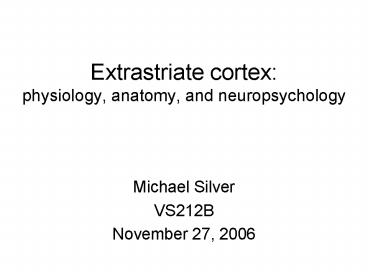Extrastriate cortex: physiology, anatomy, and neuropsychology - PowerPoint PPT Presentation
1 / 57
Title: Extrastriate cortex: physiology, anatomy, and neuropsychology
1
Extrastriate cortexphysiology, anatomy, and
neuropsychology
- Michael Silver
- VS212B
- November 27, 2006
2
VS212B syllabus
- Extrastriate cortex
- Visual attention
- Imaging methods in visual neuroscience
- Development / plasticity
3
Mound and crater
4
(No Transcript)
5
(No Transcript)
6
Connections
Example connections in monkey visual cortex
7
Human visual areas
Left hemisphere posterior view
8
Dorsal stream
Ventral stream
9
(No Transcript)
10
Spiral Motion Aftereffect
11
Visual area MT (middle temporal area)
MT
V3a
V3
V2
V1
12
Single neuron recording in area MT
13
Locating Human MT
14
Locating Human MT
15
Electrical stimulation in MT
16
Motion coherence and MT neurons
Motion stimulus
no coherence
50 coherence
100 coherence
Responses of MT neurons
Preferred direction
17
Microstimulation in MT changes motion perception
18
What happens if you have damage to MT?
Motion Blindness
19
Visual area STS (superior temporal
sulcus)responds to biological motion
STS
MT
20
Optic ataxia - posterior parietal cortex damage
21
Ventral stream
22
Daylight illuminationexamples
Blue sky
Disk of sun
23
(No Transcript)
24
(No Transcript)
25
(No Transcript)
26
(No Transcript)
27
Photometric invariance
shading
specularity
cast shadow
attached shadow
reflection
28
Cortical area V4
- Contains neurons whose responses reflect
perceived color, not physical wavelength - Damage to V4 causes cerebral achromatopsia (loss
of color perception)
29
Face perception
30
Face perception
31
Identity Aftereffects
32
pre-adapt
33
adapt
34
post-adapt
35
pre-adapt
36
adapt
37
post-adapt
38
Prosopagnosia (face agnosia)
http//www.choisser.com/faceblind/ http//www.face
blind.org/
39
Invariance of object recognition
40
Novel examples need to be recognized
41
Recognition when only part of an object is
visible
42
Recognition from unusual views
43
Response selectivity in human inferotemporal
cortex the Jennifer Aniston cell
44
the Halle Berry cell
45
Columnar architecture in IT
46
Columnar architecture in IT
47
Faces (FFA) and Places (PPA)
48
Parahippocampal place area
49
Fusiform face area
50
Faces per se or expertise?
Trained subjects to recognize this novel set of
objects
51
Face area responses depend on expertise
52
Object agnosia
- Can describe features of visual objects
- Can copy drawings of objects
- However, perception of a collection of features
as an object is impaired
Rose twig
Fencers Mask
53
Object agnosia (see only the faces)
54
Reading and letter recognition
Aoccdrnig to rscheearch at Cmabrigde Uinervtisy,
it deosn't mttaer in waht oredr the ltteers in a
wrod are. The olny iprmoetnt tihng is taht the
frist and lsat ltteer be at the rghit pclae. The
rset can be a total mses and you can sitll raed
it wouthit porbelm. Tihs is bcuseae the huamn
mnid deos not raed ervey lteter by istlef, but
the wrod as a wlohe. Amzanig huh?
55
Misbinding of color and motion
56
(No Transcript)
57
Summary of dorsal and ventral streams
- Flow of information through dorsal stream from
early visual cortex to MT and then to parietal
cortex (driven mainly by magnocellular neurons). - Dorsal stream specialized for motion processing,
spatial relationships, and spatial attention. - Flow of information through ventral stream from
early visual cortex to V4 and then to
inferotemporal cortex (driven mainly by
parvocellular neurons). - Ventral stream specialized for color and form
processing and object and face recognition.































